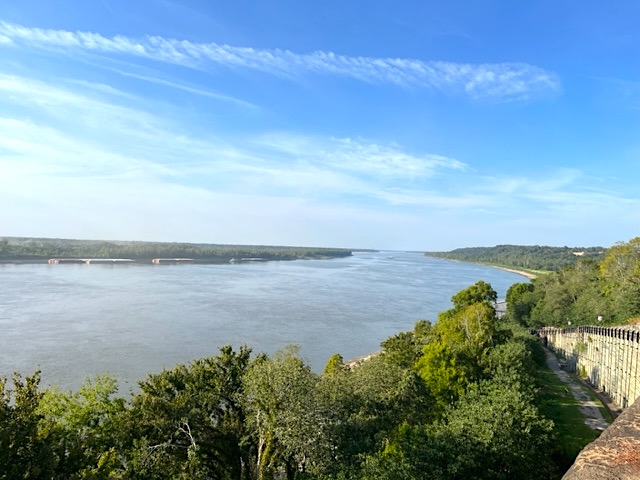
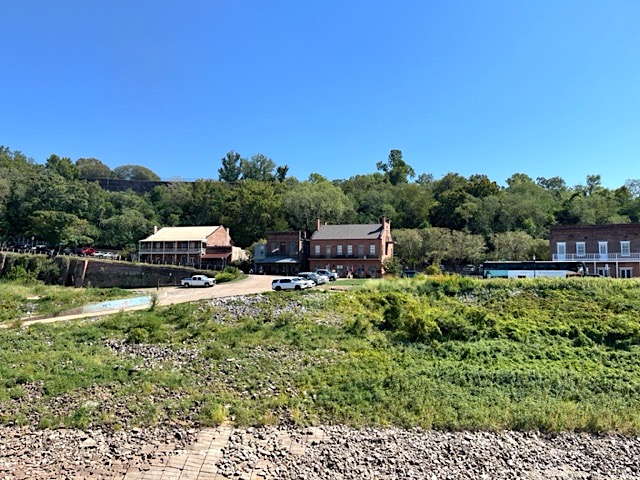
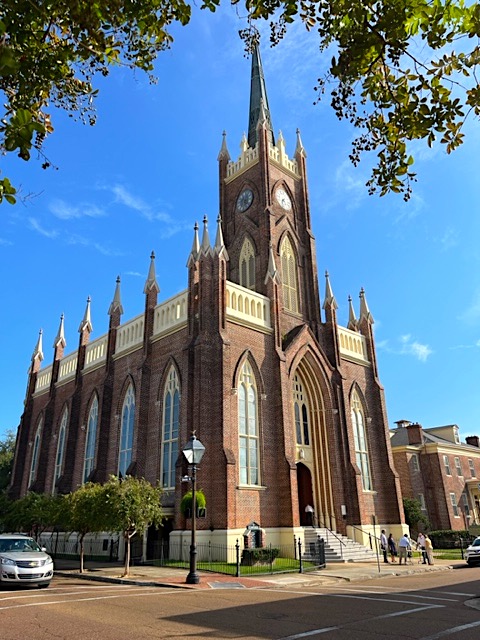
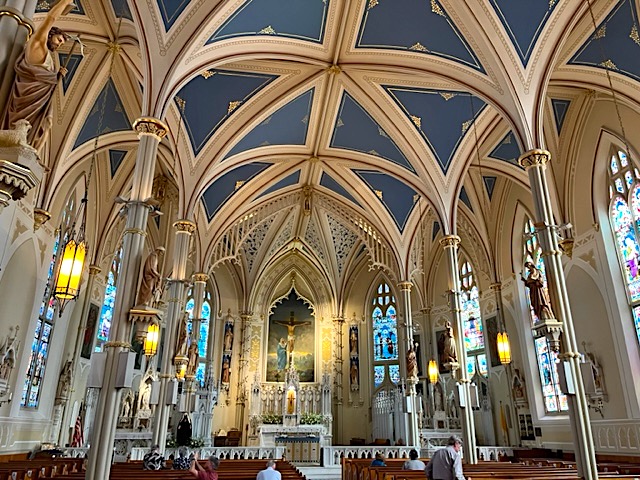
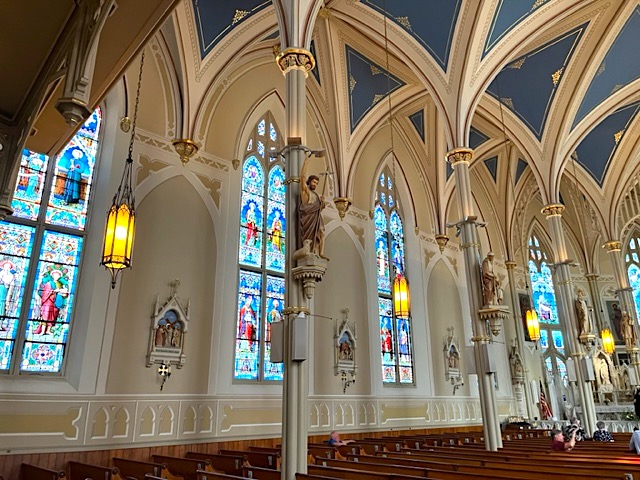
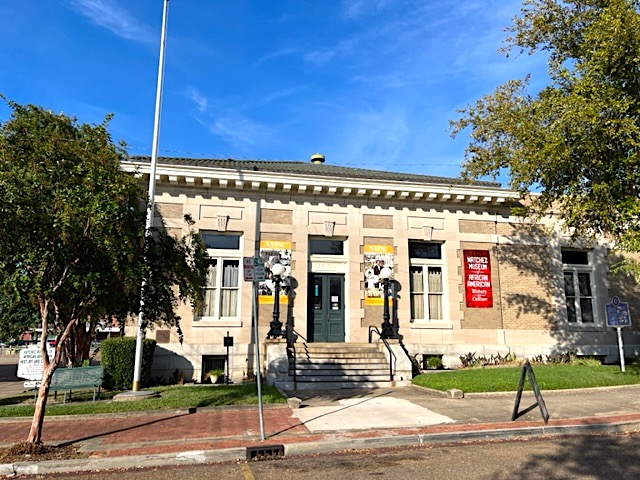
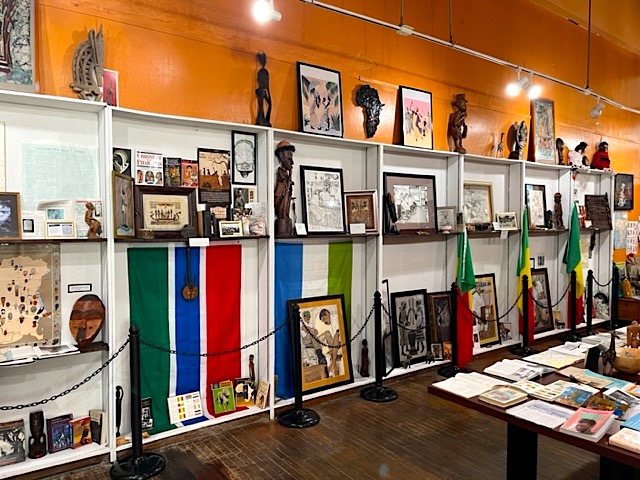

Due to the extraordinarily low water levels of the Mississippi River we were unable to stop at Vicksburg. We should have left the Mississippi River and transited up a side tributary about 1.5 miles to visit Vicksburg, but the tributary river did not have enough water for the vessel to transit. Below is some of the information about Vicksburg and the things that we were supposed to see.
Vicksburg is an historic city in Warren County with a population of about 20,000 and is located on the high bluff of the Mississippi River across from Louisiana. The area was long occupied by Natchez Native People and later settled by French colonists who built Fort St. Pierre in 1719, and was later incorporated in 1825, and named after Methodist missionary Newitt Vick.
We planned to visit the Church of the Holy Trinity, an incredible church over 125 feet long, 52 feet wide, and reaching 61 feet high to the apex of the ceiling, built of southern white pine to emulate Noah’s ark. The church was constructed in Romanesque Revival style and finished in red brick. It showcases zigzag tracery, which was highly unique to the style at the time. The Belgian slate roof is another amazing feature of the building, which began construction with the laying of the cornerstone in 1869. The 34 stained-glass windows, however, may be the main draw. They were given as memorials and six of them were created by Tiffany Studios in New York under the supervision of Louis Comfort Tiffany.
Our next Vicksburg stop was planned to be at the Anchuca Mansion. The word Anchuca derives from an Indian word meaning “happy home,” which is the exact vibe this home gives off. The original home on the property was built in 1830 by politician J.W. Mauldin. Anchuca is now listed on the National Register of Historic Places. The current home is an impressive Greek Revival style home with columns that was built around 1840 by Jane and Victor Wilson, successful merchants of the time with coal and ice businesses. It was used as a hospital during the Siege of Vicksburg in 1863. Today, the home is a bed and breakfast and its interior is beautifully furnished with fine antiques and art, but also provides modern day conveniences.
Our next stop would have been the Old Court House Museum, now a National Historic Landmark. Construction for this colossal courthouse began in 1858 and was completed in just two years in 1860 for a mere $100,000. It was well built, surviving Union shelling and a direct hit from a tornado in 1953. Now home to the largest collection of Vicksburg’s history, the museum is filled with countless artifacts, including confederate flags, portraits, the trophy antlers won by steamboat Robert E. Lee in an 1870 race, an original Teddy Bear given by Theodore Roosevelt, and much more!
The Biedenharn Coca-Cola Museum was our planned next stop in town. This building is where Coca-Cola was bottled for the first time anywhere in the world in 1894. At the Biedenharn Coca-Cola Museum, we hoped to see the equipment used to bottle the first Coca Cola as well as a wide variety of Coca Cola advertising and memorabilia in an authentic candy store and soda fountain setting. They serve ice cream, fountain Cokes, Coke floats and many Coke souvenirs for purchase.
At the Jesse Brent Lower Mississippi River Museum, they provide a unique and interactive way to learn about the history, people, and events that have been a part of the Mighty Mississippi. Their mission is to show the federal government’s role in the Mississippi River’s past, as well as future efforts to maintain a healthy river. You can step aboard the M/V Mississippi IV and experience what life was like on this unique vessel that was used as a working tow boat and as a flagship for the Mississippi River Commission. Nearly all of the vessel has been staged and can be explored. They have many other exhibits about what the 1927 flood was like for the community and you can see some of the river’s fish up close in a 1,515-gallon aquarium.
The Old Depot Museum features a 250-square foot diorama of the Siege of Vicksburg, giving us a bird’s-eye view of the layout of the Battlefield as it looked in 1863. It houses 250 scale models of ships and boats, model railroads with railroading artifacts, and 150 model cars that show the evolution of motor travel. There are also more than 40 original paintings of war on the river and Civil War artifacts.
Our last planned stop was at the Vicksburg Civil War Museum where we hoped to explore a historical museum that features a one-of-a-kind collection of artifacts from the Civil War Era. The museum was opened by Mr. Charles Pendleton, and takes a unique approach to tell the story of the Civil War, from 1860 – 1870. To fully understand this pivotal moment in the story of the United States, the Vicksburg Civil War Museum provides context and information from the years prior to the breakout of war and the reconstruction thereafter.
Back to reality….The weather was extremely warm, reaching about 90 degrees. We continued our journey towards our next port of call, Natchez, Mississippi. We arrived in Natchez, about 3:30pm and they allowed us to get off of the boat about 4:00pm. They ran three Hop-On, Hop-Off buses around town to give us an orientation around town in preparation for our full day in town the following day. We were able to visit several places before returning to our boat for the evening.
We stopped at the stunning Basilica of Saint Mary begun in 1843 but not completed for forty-years, until 1882. It includes beautiful stained-glass windows, two bell towers and a clock installed in 1881. Behind the church is a small Bishop’s Garden with a shrine of the Immaculate Conception dating back to 1847.
We then stopped at the Museum of African American History and Culture where they delve into the 300-year-old African American history, spanning four lifetimes from Colonial and Cotton Kingdom Natchez to the Reconstruction and the Civil Rights Movements. This creative portrayal of the true African American story unfolds history to reveal Natchez in a light that is shown nowhere else around. The museum features many exhibits of daily living, photographs, books and documents depicting the African American experience in the area.
The evening’s entertainment was a variety show with seven members of the crew performing a variety of musical numbers. Surprisingly, there were a lot of very talented crew members with great voices.
